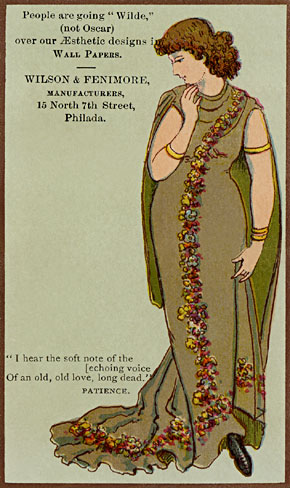



In the mid-19th century, the English art critic and theorist
John Ruskin
planted the seeds that would later flower into the Aesthetic Movement. He
led a group of artists, architects and poets in a crusade to elevate the decorative
arts to the status of the fine arts. As the movement grew, it spread beyond
artistic circles to elite aristocrats and then on to the middle class. The
movement would also cross the ocean to be fully embraced in North America.
Central to the movement was the idea that everyone's lives would be enriched
if only their surroundings could be made to be beautiful. This was largely
a reaction to the disruption wrought by the industrial revolution and a retreat
from the excesses of the prevailing Rococo style. As the movement evolved,
design giants such as William Morris, Owen Jones, E.W. Godwin, Walter Crane
and Bruce Talbert would all have a hand in shaping the aesthetic ideal; freely
mixing medieval, classical and oriental motifs to produce the distinctive
Aesthetic Movement look.

By the 1870s the Aesthetic Movement was gaining broader appeal
and much attention was given to artistic home decoration. Studied spontaneity
and casual juxtapositions replaced the stiff and formal room arrangements
of earlier decades. Soothing tertiary colors came into vogue with carpets,
draperies and wall-coverings all carefully selected to harmonize. Decorated
ceilings became popular, and dividing the wall into the horizontal bands of
frieze, fill and dado became almost obligatory. Artists and architects turned
their attention to designing wallpaper; producing a flood of patterns which
decorators combined with abandon to create exquisite effects. For the first
time, the average homeowner was treated to decorations that had previously
been the exclusive domain of the super-rich.
As the movement reached its azimuth in the last decades of the century,
sunflowers, cattails, lilies and other aesthetic motifs appeared everywhere.
James McNeill Whistler's infamous decoration of the Peacock
Room became an enduring icon of the Cult of Beauty. While Whistler
had best articulated the concept of "Art for Art's Sake", his
protégée, Oscar Wilde, would emerge as the movement's most
effective spokesman. Critics countered the movement-turned-fad by characterizing
its followers as too "intense" and by lampooning their ultra-refined
tastes and affectations.

In an odd collaboration between critics and champions of
the movement, Oscar Wilde toured the United States in 1882 at the invitation
of theatrical impresario Richard D'Oyly Carte to prepare the crowds for the
North American production of Gilbert and Sullivan's Patience. Wilde's lectures
promoted the art movement even as Patience parodied the pretense and mannerisms
of its followers. This contradiction reflected the public's fluctuating relationship
with the movement. Indeed many simply responded to the sublime decorations
put before them without adopting the underlying philosophy.
The Aesthetic Movement has left us a legacy of striking interiors and audacious
personalities, while in its own time, it delighted the public with artistic
effects which provided a sanctuary in a rapidly changing world. At a time
when beauty is once again a precious commodity, we trust these designs will
delight the current generation seeking to create an artful home. In short,
we hope you too will go wilde for these new aesthetic designs!
:: Return to Aesthetic Movement ::
Mason and Wolf Wallpaper :: PO Box 6224 :: Freehold,
NJ 07728
phone 732-866-0451 :: fax 732-866-4264 :: info@mason-wolf.com
All site contents © Copyright 2005-2019 Mason and Wolf Wallpaper :: All rights reserved.